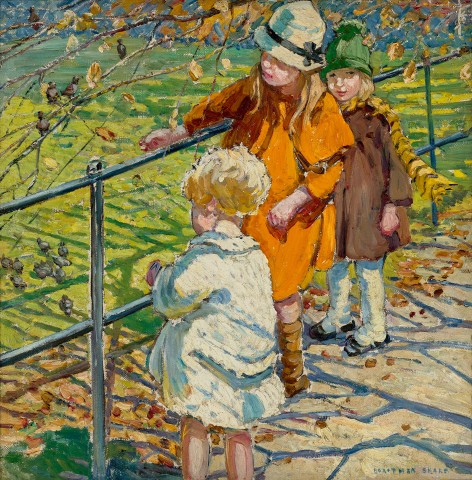THREE CHILDREN FEEDING BIRDS
DOROTHEA SHARP
oil on canvas
61.0 x 61.5 cm
signed lower right: DOROTHEA SHARP
Private collection, United Kingdom
Private collection, United Kingdom
Private collection, Adelaide
Dorothea Sharp was a highly successful British artist whose impressionistic paintings of children attracted national acclaim in the first half of the twentieth century. Sharp’s paintings follow the path set by Mary Cassat and Berthe Morisot whose own studies of children are some of the most sensitive and sought-after works in the Impressionist oeuvre. In Australian art, there is a strong correlation between Sharp’s Three Children Feeding Birds and paintings such as Jane Sutherland’s much-loved Field naturalists, c.1896, in the National Gallery of Victoria. Both works depict three children caught in an unguarded moment, fascinated by what they observe; and Sharp’s painting demonstrates the artist’s own fascination in such youthful innocence.
Born to a comfortably wealthy family, Sharp was determined to be an artist from a young age following a visit to the Royal Academy. However, her family were not supportive and she only began her studies at the age of twenty-one after receiving a small legacy from an uncle. She first enrolled at the Richmond School of Landscape Painting in Surrey, then transferred to night classes at the Regent Street Polytechnic. Whilst there, she received encouragement during school visits by Sir David Murray and Sir George Clausen, two significant British painters of the time. However, the transformative event in her development happened in 1900 at the age of twenty-six, when she went to Paris and saw the work of Monet, Matisse and van Gogh. Monet’s influence can be seen in her subsequent handling of broken colour and light, whilst the inspiration of the other two can be detected in Sharp’s preference for bright outline. On her return to London, she declined a wedding proposal to instead immerse herself in the London art scene, joining the Royal Society of British artists and the Royal Institute of Oil Painters. Initially working from a small back bedroom in her home at Carlton Mansions in Hampstead, London, Sharp had her first works exhibited at Royal Academy in 1901 and continued to do so until 1948. She visited the artists’ community in St Ives, Cornwall, in 1920, and was so delighted by what she found that she took one of the Porthmeor Studios which Sharp retained over many years. Whilst there, she was often to be found painting on the nearby beaches surrounded by children, mostly the daughters of fishermen, who were her chief sitters. She eventually moved to St. Ives permanently during World War II.
Sharp’s first solo exhibition in London was held in 1933 and sold out in a couple of days, despite being mounted at the height of the Depression. An elected member, then Vice-President, of the Society of Women Artists, her work was hung in the Paris Salon, and she exhibited alongside other famous contemporaries such as Dame Laura Knight and Sir Alfred Munnings. Three Children Feeding Birds demonstrates Sharp’s prodigious talent with its autumnal setting in a park, a charming and beautifully painted work which matches the description of her paintings given by the editor of The Artist magazine, that ‘her subjects live because they are based on the joy of life.’1
1. Sawkins, H., ‘Artists of note, no. 2: Dorothea Sharp, ROI RBA’, The Artist, London, vol. 9, no. 2, April 1935, pp. 55 – 58
ANDREW GAYNOR
